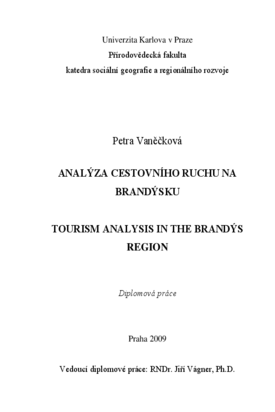Analýza cestovního ruchu na Brandýsku
Tourism analysis in the Brandýs region
diplomová práce (OBHÁJENO)

Zobrazit/
Trvalý odkaz
http://hdl.handle.net/20.500.11956/25322Identifikátory
SIS: 52358
Katalog UK: 990011728550106986
Kolekce
- Kvalifikační práce [21483]
Autor
Vedoucí práce
Oponent práce
Nosková, Alena
Fakulta / součást
Přírodovědecká fakulta
Obor
Regionální a politická geografie
Katedra / ústav / klinika
Katedra sociální geografie a region. rozvoje
Datum obhajoby
24. 9. 2009
Nakladatel
Univerzita Karlova, Přírodovědecká fakultaJazyk
Čeština
Známka
Velmi dobře
Hlavním cílem této diplomové práce je komplexní posouzení problematiky cestovního ruchu a rekreace v modelovém regionu v severovýchodním zázemí Prahy. V první části je analyzován rekreační potenciál regionu z pohledu předpokladů pro rozvoj cestovního ruchu a možností jeho různých forem. Důraz byl kladen na vývoj a specifika druhého bydlení (prostorové rozmístění, ukazatele rekreačního zatížení území aj.) a perspektivy jiných forem cestovního ruchu (poznávací, kulturní a náboženský cestovní ruch, cykloturistika aj.) s ohledem na suburbanizační proces v regionu. Druhé bydlení může představovat překážku pro další suburbanizační funkce a omezení pro rozvoj jiných funkcí rekreace a cestovního ruchu. Další část studie se zaměřuje na zhodnocení organizace a řízení cestovního ruchu v regionu (významné projekty a investice). Závěrečná kapitola shrnuje hlavní zjištění. Hlavní výzkumnou metodou je dotazníkové šetření (uživatelé objektů druhého bydlení, návštěvníci, ubytovací zařízení, představitelé obcí) spojené s analýzou dostupných dat. Vybrané důležité výsledky jsou zobrazeny v tabulkách a grafech. Fotografická dokumentace je ilustrativní součástí studie. Powered by TCPDF (www.tcpdf.org)
The main objective of this diploma thesis is to examine aspects of tourism and recreation in the model region in the northeast hinterland of Prague. In the first part the recreational potential of region is analyzed, paying attention to predisposition to tourism development and its possible different forms. Stress was given to evolution and specifics of second housing (spatial distribution, characteristics of recreational use etc.) and perspectives on other forms of tourism (cognitive, culture and religious tourism, bicycle tourism etc.) with respect to suburbanization process in the region. Second housing can be a barrier for other suburbanization functions and a limit for development in other recreational and tourist functions. The next part of the study focuses on organizing and managing tourism in the region (significant projects and investments). The final chapter summarizes the main findings. Main research method of the study is questionnaire surveys (second home users, visitors, accommodation facilities, municipal representatives) joined with available data analysis. Selected important results are given in tables and graphs. Photo documentation forms an illustrative part of the study. Powered by TCPDF (www.tcpdf.org)
